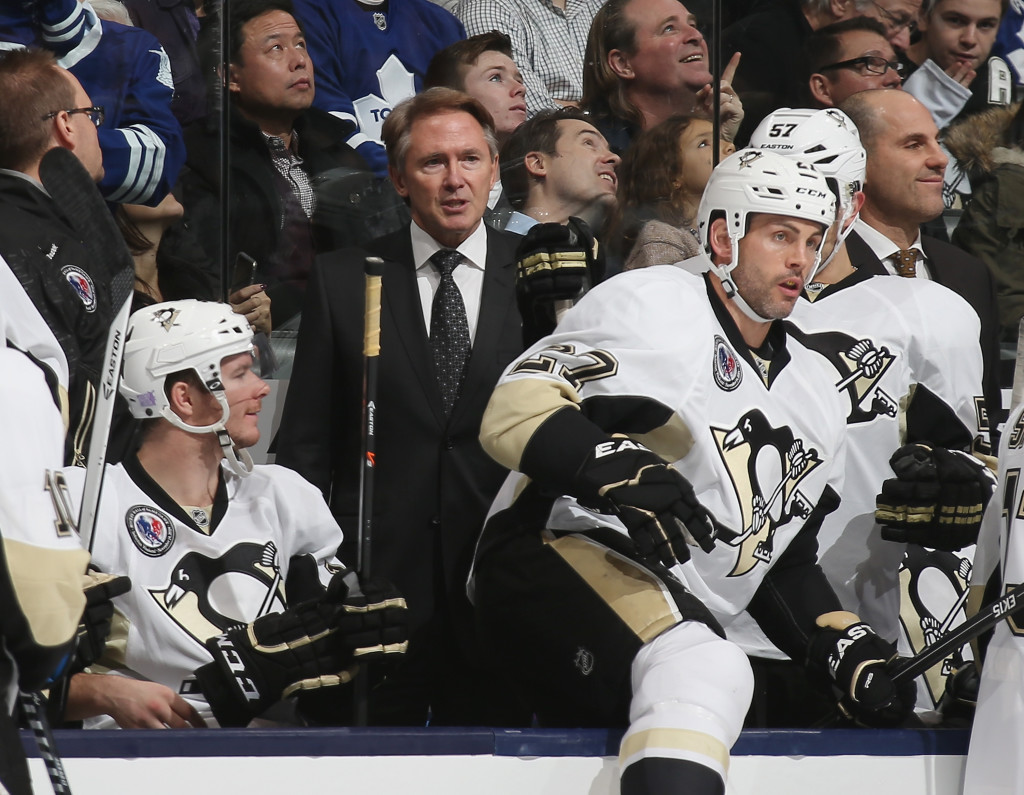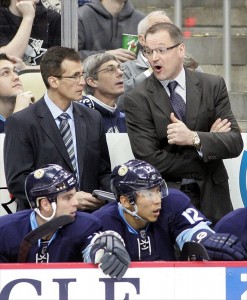The Pittsburgh Penguins had a strategy for everything under former coach Dan Bylsma.
In one off-ice clip from last year’s training camp, I saw Bylsma reviewing multiple versions of a 4-on-4 faceoff play for the right faceoff dot in the offensive zone. I’m not kidding.
The heavily-scripted style of play overwhelmed some of Pittsburgh’s more instinctual players — Kris Letang — and completely confused any newcomers that came in via trade.
Mike Johnston made an effort to simplify the game when he took over as head coach of the Penguins in the fall. The results were noticeable. It was as if Bylsma cooked dinner with 30-step, 19-ingredient recipes from Bon Appétit while Johnston insisted on improvising with whatever was already in the fridge.
If Kris Letang is an instinctual player, Johnston reasoned, then why not let him take advantage of his instincts? Let him join the rush in the offensive zone. Let him attack the net and stay in front as a forward. Too much structure prohibits great players from being great.
Johnston’s coaching style had a liberating affect on the Penguins. Players seemed relaxed. The wins piled up.
The biggest question for the Penguins was what would happen once the league figured out their simplified system? Less complexity is a positive, until it means teams can easily scout you overnight.
The Penguins won 66% of their games this season when facing a team for the first time. In the second meeting between teams, the Penguins winning percentage dropped to 52%. After the second game and beyond, their winning percentage was just 39%.
Of course, Pittsburgh’s injuries in the second half of the season certainly played a role in those results, but the numbers don’t lie from a strategic perspective.
After about six weeks of the regular season, the NHL had Mike Johnston figured out. He’s tried to adapt — tweaking defensive zone coverage and breakout positioning — but the cohesiveness the Penguins exhibited coming out of training camp is gone.
At the root of the struggles in recent weeks is the breakout. Injuries to key defensemen (Olli Maatta, Kris Letang, and Christian Ehrhoff) and trades for new bodies (Ben Lovejoy, Ian Cole) have meant too much roster turnover and sloppy execution.
Mike Johnston breakouts aren’t difficult, but they need to be executed flawlessly. That hasn’t been happening and it impacts goals against, goals for, and everything in between.
Let’s look at a number of examples from the first period of Friday night’s game against the NY Islanders to get a better understanding.
The first job for a defenseman on the breakout at any level of hockey is to evaluate pressure. If a forechecker isn’t draped on top of the defenseman, Johnston wants his players to fake one direction and go the other way.
Watch Ian Cole’s (#28) stick in this example:
Impossible to notice during a broadcast at full-speed, but the quick stick fake gets Ryan Strome of the Islanders to think Cole is going up the boards, even if just for a split-second. That’s enough to give Cole separation and the chance to round the net to make a clean breakout pass.
Solid execution.
So what happens if Strome doesn’t fall for the stick fake?
At least half the teams in the NHL employ a tactic called a reverse to evade pressure and maintain control of the puck. In the clip above, watch as Rob Scuderi floats in behind Cole and Strome.
If Cole can’t shake Strome, he can simply bump the puck off the boards back to Scuderi. This read-and-react play requires familiarity between defensive partners as well as a lot of verbal and non-verbal communication. The defenseman picking up the puck needs to read pressure effectively and then also have a partner in position to provide support on the reverse.
The support can also come from a winger or center swinging in low for support. The parts are interchangeable but the tactic is the same. Defenseman reads the pressure, then reacts accordingly.
Let’s look at an example of how new players are leading to issues for the Penguins.
In this play, Ben Lovejoy (#12) goes back to retrieve the puck with light forecheck pressure coming from the middle of the ice:
Lovejoy looks over his shoulder twice as he’s heading back and should be considering two options.
One would be to bank a pass behind the net to his defensive partner Taylor Chorney. The other would be to execute a reverse with Sidney Crosby as Crosby loops low for support. The forechecking pressure isn’t from behind Lovejoy, so a reverse makes little sense in this situation — the forward would simply have to change direction and collapse down on Crosby instead.
Crosby even looks at Lovejoy, who doesn’t make an immediate pass for a reverse, before taking off up the boards. The puck ends up being turned over and eventually Lovejoy panics and ices it. The communication breakdown is understandable for two players who have only played 20 games together this season.
The Islanders — who had already seen Johnston’s Penguins four times this season — also had Pittsburgh’s breakout completely scouted.
Their counterstrategy was to send one forward hard on the forecheck to pressure a mistake like we saw in the Lovejoy example. The other two forwards would stay extremely wide, taking away any and all breakout passes up the boards. Division teams have been doing this to the Penguins all season.
If the Penguins breakout up one side, the other forward comes across and cuts the ice in half, ensuring that no pass can go to the other side. Watch New York’s Anders Lee (#27) come down the near-side boards and then up through the middle on this play:
His stick is positioned to eliminate any cross-ice passes and Penguins end up trapped at the blueline.
A big reason the Penguins were even able to exit the zone at all on that play was that Fleury was able to handle the dump and set the puck up for Cole to kickstart the breakout. What the Islanders did well on a number of other occasions on Friday was a hard dump around the boards, making it almost impossible for Fleury to stop the puck or the Penguins to execute their reverse.
Watch as Rob Scuderi (#4) has no option on this dump but to protect the puck with his body and absorb the forechecker’s hit.
If you’ve made it this far, then you’re ready for the masterclass example in NHL Breakouts & Forechecks from Friday’s game.
Look for everything we’ve discussed so far in this clip: evaluating pressure, defense reverse, forward support down low, the Islanders’ forecheck, and even the positional swap between Evgeni Malkin (#71) and David Perron (#39).
A solid attempt and rotations by the Penguins, but a flawed second reverse eventually leads to a turnover. The Islanders were prepared for everything.
Bylsma was criticized — and ultimately fired — for his inability to adapt his coaching strategies in the playoffs.
If Mike Johnston is going to avoid a similar fate, he’ll have to find a way to inject some creativity into the Penguins playbook against the Rangers. Otherwise, it could be an incredibly short series.


